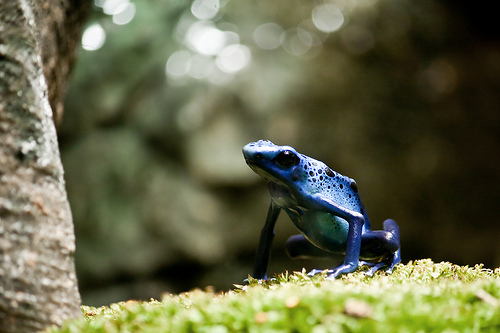Blue poison dart frogs are brilliant, beautiful and baleful.
- Blue poison dart frogs are paralysing toxic frogs native to the rainforests of the country Suriname, in north-eastern South America.
- ‘Blue poison dart frogs’ are also known as ‘blue poison arrow frogs’ and, in the native language, ‘okopipi’.
- Blue poison dart frogs have the scientific name Dendrobates tinctorius ‘azureus’, referring to the frogs azure blue skin colour, and they are from the family Dendrobatidae, the family of poison dart frogs.
- Blue poison dart frogs can reach lengths of 3 to 4.5 centimetres (1.2 to 1.8 inches) and be as heavy as 8 grams (0.3 ounces) in weight.
- Typically, blue poison dart frog females are larger than males in size, but males have four larger toes that end with heart shapes, compared to the female’s four smaller toes that end rounded.
Blue Poison Dart Frog Image courtesy of Tom Thai/Flickr
- The blue poison dart frog has a vibrant azure blue skin colour, and is spotted with a unique pattern of black spots, which alerts predators of the frog’s poisonous content, and if a predator is poisoned by the glands in the skin, they are usually paralysed by them, which can cause the predator to die.
- Blue poison dart frogs breed during the wet season, with two to ten eggs per clutch, which take two to three weeks to hatch.
- Blue poison dart frog tadpoles measure around one centimetre (0.4 inches) in length and are not toxic like adult frogs, and although the adult frogs are found near water bodies, they do not swim.
- Blue poison dart frogs’ diet mainly consists of insects, including ants, beetles, caterpillars and flies, and sometimes spiders.
- In the wild, blue poison dart frogs live an average of five years, but in captivity they can live up to ten years.
Bibliography: Blue Poison Dart Frog, 2014, National Aquarium, http://www.aqua.org/explore/animals/blue-poison-dart-frog
Blue Poison Dart Frog, 2014, Tampa’s Lowry Park Zoo, http://www.lowryparkzoo.com/bio_florida_bluepoisondartfrog.php
Blue Poison Dart Frog, 2014, Wikipedia, http://en.wikipedia.org/wiki/Blue_poison_dart_frog







